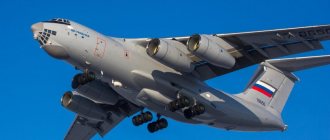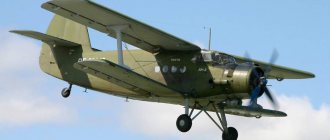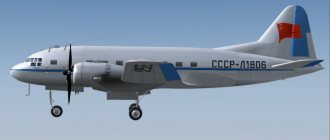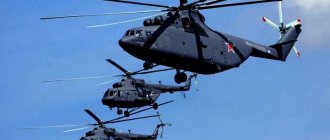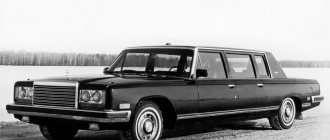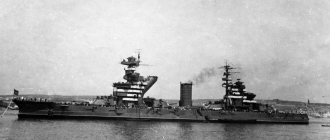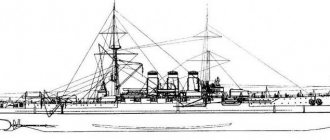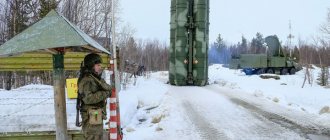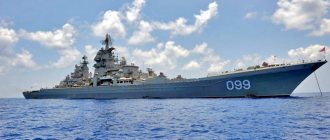As for the production of Il-76 aircraft by modifications and their deliveries to various operators, these data are presented in Table 1.
Of the 20 Il-76s of various modifications returned by Iraq, 4 of them were transferred to Aeroflot and 16 to the MAP and IOM structures.
Table 1
It is worth planning for the period 1992-2000. build another 300 Il-76, i.e. The USSR was supposed to enter the new millennium with almost 750 machines of this type. It is interesting that 300 aircraft is almost 10 VTAP, and only two aviation regiments (Fergana and Zavitinsk) did not have time to switch to the Il-76 in the Soviet VTA. Even taking into account the fact that some of the new aircraft would replace earlier versions of aircraft in service, it would not have been possible without the formation of new VTAPs.
In the second half of the 80s, the replacement of Il-76 and Il-76M with more modern Il-76MD began at VTAP, based in Vitebsk (1986-91) and Novgorod (1987-91). At the same time, early modifications entered service with other VTAPs as part of the re-equipment from the An-12 to the Il-76 (for example, in Ukurei).
Of no less interest is the exchange of Il-76s between aviation regiments. In total, about 340 aircraft were “moved” in this way. At the same time, the “record holders” for the transfer of “boards” to other units were VTAP, stationed in Novgorod, Tartu and Ukurei. Each of them handed over 36 aircraft. The largest number of aircraft were accepted by VTAP, stationed in Orenburg (60 aircraft, after the collapse of the USSR) and pulp and paper plant in Ivanovo (49 aircraft).
The largest number of initial deliveries of Il-76 were made to Melitopol (63 vehicles for two regiments), Novgorod and Vitebsk (57 vehicles each).
Rare photo. In this photo, Il-76 Vasilkovsky VATU is still alive
As of the beginning of 2008, 46 civil aviation companies included 190 IL-76s of various modifications, of which 140 were in the CIS countries. However, not all of them are in flying condition, just like military vehicles.
The most durable
Of the almost 935 Il-76s built, about 65 aircraft were lost due to aviation accidents, of which about 46% were lost due to the “human factor”, and 19% due to the failure of aircraft equipment, which indicates the high reliability of this aircraft. Due to aircraft failures, in the period before 1992 there were only two Il-76 aviation accidents: on November 23, 1979, the crew of the Vitebsk VTAP crashed due to asynchronous flap release. After this, the aircraft's flap retraction and extension system was modified. And on October 18, 1989, on the Il-76, which belonged to the Artsyz VTAP, the intershaft bearing of the D-30KP 2 series engine was destroyed, followed by a fire and destruction of the aircraft structure. Despite the measures and improvements taken, after the collapse of the USSR, a number of accidents and disasters were recorded for the same reason. But here there are more questions about the engine, and not about the aircraft as a whole.
In general, the machine forgave a lot: takeoff without mechanization with a weight of almost 170 tons (Fergana, 1989), landing without landing gear, early retraction of the landing gear on landing, boosterless control with a bare wing on a de-energized aircraft.
Il-76 losses by year
The true causes of a number of aviation accidents have not been established. Thus, on August 10, 1988, the Il-76, which was climbing after passing the landing site during scheduled flights, began to climb at a vertical speed of 25-27 m/s, and then abruptly switched to a descent with a vertical speed of up to 45 m/s and collided with the ground. The cause of the disaster was stated to be the crew's incapacitation due to a discharge of atmospheric electricity hitting the plane. They also spoke about the “inadequate behavior” of the aircraft control system in the area of near-zero overloads, which arose when the aircraft was transferred to climb.
In another case, which took place on February 1, 1989, during the climb after a previous takeoff “from the assembly line,” the plane began to descend and collided with the ground. Presumably, the cause of this incident was again the “inadequate behavior” of the aircraft control system in the area of near-zero overloads, which arose when the aircraft was put into climb. After this incident, flights “from the assembly line” for the Il-76 were prohibited, and the control systems of all of them were subjected to a thorough inspection.
In the third case, which took place on April 15, 1990 (according to other sources - April 7, 1991), the Il-76, which was climbing in the Engels area, began a spontaneous intensive descent. Only three crew members (two pilots and an on-board technician, who rested his feet on the instrument panel and helped pull the steering wheel towards himself) managed to bring the plane into horizontal flight at an altitude of about 400 m (according to other sources, at an altitude of 20-40 m). The aircraft received significant structural damage, but it was not possible to name the true reason for the “inappropriate behavior” of the aircraft... However, the aircraft was later restored and continued further operation.
The list of losses of Il-76 aircraft known to the author is presented in Table 2.
table 2
A number of aircraft were written off as a result of aviation accidents, however, the author has not yet been able to establish their exact date.
Thus, the USSR-86742 aircraft was written off on April 18, 1989, USSR-86854 - after a rough landing as a result of falling into a ground fog zone, USSR86031 was written off after it was damaged in the parking lot by a helicopter. The last two cars were transferred as teaching aids to Vasilkovsky VATU, where they were disposed of 3-4 years ago. The RA-86859 aircraft was written off in the winter of 1995-96. after a rough landing in Shadrinsk.
In addition, some of the vehicles were written off quite quickly after their delivery to the operators: for example, the Il-76 USSR-76511 flew for only 2 years and was transferred to the museum of the Kiev VVAIU, the Il-76MD USSR-76492, which was used to test the D-90A engine ( future PS-90), - 3 years, and Il-76MDPS USSR-76621, which was involved in testing means of search and rescue at sea - only 5 years, after which it was transferred to the museum of the Voroshilovgrad VVVAUSH. There is a high probability that these vehicles also suffered structural damage, which is why they were written off so quickly.
New life for '76
In 2006, the Russian government issued an order to organize the production of Il-76 aircraft in Russia. Work on the creation of the heavy transport aircraft Il-76MD-90A and the organization of its serial production at the Ulyanovsk Aircraft (part of the UAC state corporation Rostec) was carried out under the leadership of the general director - general designer of Ilyushin, Viktor Livanov, from 2006 to 2014.
Modern global trends in aircraft manufacturing, new requirements of modern technologies for the design and manufacture of aircraft have required the Aviation Complex named after S.V. Ilyushin application of innovations: it was decided to digitize paper drawings and create three-dimensional models based on them using modern programs. For the first time in Russia, such a complex project was completed entirely in digital form: from the creation of design documentation to the production of a serial aircraft.
The most modern modification is the Il-76MD-90A, the service life and first flight samples of which were assembled at Aviastar-SP in 2011. On October 4, 2012, in the presence of Russian President Vladimir Putin, the aircraft made its first demonstration flight.
“The IL-76MD-90A allows solving most of the tasks of military transport aviation at a qualitatively new technical level and meets both the current and future requirements of the Russian Ministry of Defense,” Sergei Yarkova, First Deputy General Director of the UAC, Managing Director of PJSC Il, told TASS.
Il-76MD-90A © Armen Gasparyan/Il PJSC
The list of main distinguishing features of the deeply modernized aircraft includes more powerful PS-90A-76 engines, a reinforced wing and a modernized chassis, and a new flight and navigation system. As Andrey Yurasov, chief designer of the Il-76MD-90A, told TASS, the aircraft can be operated in harsh climatic conditions at extremely low and high temperature conditions. “The IL-76MD-90A can be operated in any climate zone, including Africa, Antarctica and the Arctic. It is capable of transporting a wide range of cargo anywhere in the world,” he said, adding that, despite the external similarity, the modernized version of the Il-76MD-90A aircraft is significantly different from its predecessor, the Il-76MD.
According to him, during the modernization, the transport load of the Il-76MD-90A increased to 60 tons, the flight range increased by 25% (compared to the Il-76MD), and fuel consumption was reduced by 17%.
Yurasov also notes that the aircraft implements the principle of a “glass” cockpit, which significantly increases piloting efficiency.
Instead of the usual analog instruments, there is a digital display field for aircraft systems and equipment: there are nine screens in the aircraft cockpit.
This option is more informative: it is much easier for crew members to perceive a compact frame that reflects the spatial position of the aircraft, its speed, altitude and other flight parameters and necessary information Andrey Yurasov, chief designer of the Il-76.78
According to him, for the first time in the history of the domestic military transport aircraft, a military transport aircraft received a video recording system, which allows full control of the process of landing and loading/unloading cargo.
“The new digital autopilot allows landing in the second ICAO category, when the plane is brought to a height of 30 m above the runway in automatic mode, and then lands in manual mode,” says Yurasov, noting that the predecessor “flyed in the first category , that is, in this case the decision height is 60 m.”
In terms of aircraft navigation characteristics, the new machine, according to him, meets the current and future requirements of ICAO and Eurocontrol, which allows flights to any civil airport in the world.
Despite the deep modernization, the Il-76MD-90A retained the legendary reliability of the base model. “Compared to foreign analogues, the Russian aircraft has a high degree of operational autonomy and does not require additional sets of equipment and people for loading and unloading cargo. All functions can be provided by the crew itself, which consists of six people,” added Yurasov.
Like previously developed aircraft of this family, the Il-76MD-90A can be the base platform for an entire family of aircraft. In particular, according to Yurasov, the vehicle can be configured as an aircraft for airdropping supply cargo, a firefighting aircraft, a humanitarian aid aircraft, or a rescue aircraft.
Il-76MD © Alexey Nagaev/PJSC "Il"
“The new machines are in mass production, and it is expected that the pace of their production will be increased. The aircraft has been redesigned digitally. Today we are increasing the rate of serial production of the Il-76MD-90A: our plans are to produce up to 12 aircraft per year. For this purpose, Aviastar-SP launched a new automated assembly production line,” Yarkova said.
We look confidently into the future.
The use of new design methods and modern production technologies provide the opportunity for further effective modernization of the aircraft and the creation on its basis of aircraft for a wide variety of purposes, special aviation complexes that meet all Russian and international requirements Sergei Yarkova, First Deputy General Director of UAC, Managing Director of PJSC Il
Fate
Like a person, an airplane has its own destiny. Here are just two examples. In the aviation museum in Monino there is an Il-76 USSR-86047, and few people wonder how it got there. And the fate of this “tenacious” aircraft is quite interesting.
In September 1979, this aircraft arrived in Panevezys, and a week later it was transported to Tartu. A month later, during night flights, its landing gear was retracted before lifting off the runway. Sparks rained down in all directions... On landing, one tire burst, and the remaining 15 were cut down to the last cord, but did not burst.
Rare photo. The famous “indestructible” Il-76 parked in Monino
Soon 86047 ended up in Kėdainiai, and then in Panevezys. On March 14, 1985, it landed without landing gear (they simply forgot to release them). The plane was lifted on pneumatic fabric lifts, gradually laying supports from sleepers under the planes, the pneumatics and landing gear doors were replaced, the cabin was patched up and it was driven to Tashkent. They ferried it without retracting the landing gear, with several intermediate landings. After repairs, the board returned to Panevezys.
In one of the flights (August 1987), during a go-around, the crew commander did not give the required commands to increase the engine speed to take-off, the senior on-board technician increased it according to his understanding to the nominal value and removed the mechanization. As a result, the plane dropped from 200 m to 15 m and began to catch trees. The crew increased engine operation and were able to gain altitude. After landing, as eyewitnesses recall, “we pulled out a lot of tree branches from the engines and gaps in the places where the ailerons were mounted.” The landing gear doors were also heavily damaged.
Il-76 TD at Machulishchi airfield, near Minsk
The plane was repaired in Kėdainiai, but, according to rumors, the BTA commander said something like: “We won’t wait for a third time” and ordered the plane to be transported to Monino. But even here, during landing, the plane almost rolled off the runway. There he finally found peace...
The fate of the Il-76 USSR-78821 is the direct opposite of the “survivable” 86047. After arriving at the aviation regiment, the aircraft received damage to the nose. The evening before the incident, the plane was delivered by a TZ-22 tanker. In order for it to land not on the ground (it was wet), but on concrete, the plane was rolled out of the parking lot towards the MRD a little. The TK was successfully unloaded, but then it turned out that the civilian driver of the tractor had finished his work day and had driven it to the park. They decided to completely park the plane later in the morning. But late at night, one of the regiment’s aircraft returned from a business trip, which, while taxiing, smashed the nose of 78221 with the tip of its wing. And the aircraft was practically new (about 400 hours of flight time).
After the incident, 78821 was parked for almost 10 years, being a “donor” for other Il-76s, until it was transferred to one of the airlines. But even here the plane flew for less than a year: on April 18, 2001, during takeoff from the Ostend airfield (Belgium), an engine malfunction alarm sounded on the plane. The crew commander made a decision: to stop the takeoff and taxi along the high-speed taxiway. While entering it, the plane came off the concrete, broke one of the struts and “loaded” in the ground. They did not restore it, and it was soon dismantled. Fate…
How the legend was created
The development of a new turbojet military transport aircraft began in June 1966, and already in the winter of the following year, General Designer Sergei Ilyushin approved a technical proposal for the creation of a military transport aircraft with D-30KP turbofan engines. Work on the project was headed by Deputy General Designer Genrikh Novozhilov, who in the spring of 1970 became general designer and responsible head of the Ilyushin Design Bureau. In accordance with the technical specifications of the Air Force, the new aircraft had to have good takeoff and landing characteristics, be operated from any runways (runways), including unpaved ones with low soil density, and take off from a runway no longer than 2.5 thousand m. The vehicle was supposed to be distinguished by high load-carrying capacity - in particular, it was assumed that it would be capable of transporting 20 tons of load over a distance of 5 thousand km.
© ilyushin.org Sergei Vladimirovich Ilyushin’s successor as general designer is Genrikh Vasilievich Novozhilov.
From the very beginning of development, special attention was paid to the multi-tasking of the new aircraft - it was assumed that it would not only deliver cargo, but also carry out airborne assault. The first experimental IL-76 was ready in January 1971.
© aviaru.rf
The first experimental IL-76.
On March 25, 1971, the Il-76 took off for the first time. After the crew reported that they were ready for flight, Novozhilov, in the presence of Ilyushin, signed the flight sheet, and did so on the hood of his black Volga. Since then, signing flight sheets for the first flight of experimental aircraft on the hood of the Volga has become a tradition of the Ilyushin Design Bureau.
Serial production of the Il-76 was launched at the Tashkent Aviation Production Association named after V.P. Chkalova. By the mid-1980s, the vehicle became the main heavy military transport vehicle of the BTA.
Reference
As of the beginning of 2022, 958 Il-76 aircraft of various modifications were produced, of which 118 aircraft (12.4% of production volume) were exported between 1978 and 2005. The Air Forces of Iraq, Syria and Libya were the first to purchase the aircraft. Over time, the geography of supplies has expanded - at the moment, aircraft of the Il-76 family are operated in 24 countries in Europe, Asia, Africa and North America. 840 aircraft were delivered to domestic customers. The plane set 25 world records.
© ilyushin.org
March 25, 1971 at the Central Airfield named after. Frunze in Moscow, the crew under the command of Honored Test Pilot of the USSR Eduard Kozlov performed the first flight of the heavy military transport Il-76.
Prospects
Work to expand the capabilities of the Il-76 was not limited to modifications of the Il-76MD and Il-76TD. The first attempts to create an extended version of the Il-76 (designated Il-176) date back to 1976, apparently influenced by the creation of the C-141B aircraft by American aircraft designers. At the same time, it was found out that with the existing D-30KP engines, the aircraft has no advantages over the conventional Il-76. Since the late 70s, work has been carried out to create more powerful engines D-30KP-30 with a thrust of 14,000 kgf and D-30KP-30-17 with a thrust of 17,000 kgf. Subsequently, the extended version (with the D-30-KP-30) was returned in 1980, but full-fledged work, culminating in the creation of a real Il-76MF aircraft, began only in 1987. On September 1, 1995, the new aircraft made its first flight, and its state tests were completed on April 22, 2003.
It is equipped with more powerful PS-90A-76 engines with a thrust of 14,500 kgf, new equipment, in particular, the new PNPK (sighting and navigation aerobatic complex) “Kupol-3”. The cargo compartment was lengthened by 6.6 m, which ultimately made it possible to increase the flight range by 15-20%, the carrying capacity by 22 tons and reduce fuel consumption by 12%. The TA-6A auxiliary power unit (APU) was replaced with a VKTD-43, similar to that installed on the Tu-204. During testing (in the summer of 2000), the aircraft carried out landings on six P-7 platforms, and also used the inertial landing method (creating a pitching angle and shifting the platforms under its own weight). The aircraft crew was reduced to 5 people: the “services” of the on-board radio operator and the operator of the aft gun mount were abandoned.
The first Il-76MF built for Jordan (Il-76EI)
They also tried to abandon the senior air gunner in combat units, but not everything turned out to be so simple: in addition to performing a number of important duties when flying in combat formations, his role is also important during the pre-flight check of aircraft controls. Therefore, soon the crew of the military IL-76 again began to consist of 7 people.
Table 3 provides basic data on transport modifications of the aircraft.
Table 3 (* - planned)
State tests of the Il-76MF were completed in 2010.
In the mid-90s, according to news agencies, the Russian government signed an agreement with the Tashkent Aircraft Plant for the construction of another 100-120 aircraft of this type until 2010. However, plans remained plans...
Rolling out the Il-76MF after painting
Also, at a certain stage, it was planned to continue the production of “regular” Il-76MD, but with the installation of new cabin equipment, incl. and multifunctional indicators; equipping the aircraft with a fly-by-wire control system; installation of a new PNPK. The crew was supposed to be reduced to 4 people.
Table 4
It was planned to equip the Il-76MD, which was in service with the Russian Air Force in 2011, with PS-90A76 engines with a thrust of 14,500 kgf, which would increase the aircraft's MVM to 200 tons, the weight of the transported cargo (up to 50 tons), and also reduce fuel consumption (by 17- 19%). Aircraft of this version were designated Il-76MD-90. The aircraft of this modification made its first flight on December 27, 2006
The “first sign” in the issue of remotorization of aircraft of this type was the civilian Il-76TD-90VD, which first took off on May 5, 2005 and was delivered to the air. The second machine built for this company took off in July 2007. Its current plans include the purchase of three more aircraft of this version with an option for another 10 aircraft. In addition, two Il-76TD-90s have been delivered. The maximum capacity of vehicles of this type is 195 tons, and the weight of the transported cargo is 50 tons.
IL-76: a veteran who is not planning to retire
46 years ago, on March 25, 1971, the first prototype of the most popular military transport aircraft of the post-war USSR took off on its first flight.
Il-76MD of Russian military transport aviation in the sky over Moscow.
Photo from the site This plane did not make it to the Vietnam War, but it was to a large extent a product of it. But after Vietnam, he did not miss a single more or less noticeable military conflict - neither on the territory of his native country, nor in many countries beyond its borders. It has a characteristic silhouette that cannot be confused with anything else, and is capable of literally changing its specialization in a matter of hours, turning from a truck into a passenger airliner, and from a parachute landing aircraft into a tanker or firefighting aircraft. Yes, and he also has two and a half dozen world records to his name.
All this is about the same Il-76 aircraft, which from the mid-1970s to this day has been the basis of military transport aviation in the Soviet Union and Russia. And it will remain so, apparently, for quite a long time, since the modernization resource of the machine, which became the swan song of the seriously ill Sergei Ilyushin, turned out to be surprisingly large.
IL-60 - “grandfather” of IL-76
The first approach to creating a new generation of military transport aircraft was made by Sergei Ilyushin, who always knew how to look forward and work for the future, back in 1960. On February 26, he sent a letter to the Chairman of the State Committee on Aviation Technology, Pyotr Dementyev, in which he proposed to consider the project of the Il-60 military transport aircraft prepared by his OKB-240 on an initiative basis. It was a mid-wing aircraft, equipped with four turboprop engines (a low-wing aircraft with the same propulsion system was also considered as a second version of the project), capable of lifting 40 tons of cargo and transporting them over a distance of 3000 km, and with a ten-ton load its range reached 8700 km.
The main layout of the IL-60 is a mid-wing. Photo from the site https://aviadejavu.ru
This is how Sergei Ilyushin himself described the capabilities and tasks of this machine in his letter: “The aircraft is designed for transportation and parachute landing of heavy military equipment, industrial cargo and soldiers with weapons. A sanitary version of the aircraft is provided. The flight weight of the aircraft is 129.2 tons. The cargo compartment has a square section of 4m x 4m and a length of 30 m and provides transportation of 40 tons of cargo (cargo weighing up to 50 tons is allowed due to a decrease in fuel supply) or 400 soldiers with the necessary equipment, or 280 people wounded on stretchers. Parachute landing of cargo weighing up to 15 tons is provided. The technical flight range is 4130 km with a maximum payload of 40 tons and a fuel reserve of 55 tons. The aircraft ensures continued takeoff with three operating engines, and the use of large diameter propellers and special flaps allows for a takeoff weight of 129.2 t to obtain a run length on the ground of no more than 1000 m (with a soil strength of 7 kg/cm2) and a run length on concrete of 750 m, with a landing weight of 109.2 t.”
Options for placing equipment and cargo in the cargo compartment of the IL-60. Photo from the site https://aviadejavu.ru
The aircraft designer did not receive a positive response to this proposal - at that moment, the minds of the leadership of the aviation industry and the military were dominated by the new brainchild of OKB-153 of Oleg Antonov, who took on the creation of the world's first wide-body aircraft, the A-22 Antey. But at the same time, it is very interesting to pay attention to this coincidence. Both the future An-22 and the Il-60 project envisaged the creation of an aircraft with a payload capacity of 40-50 tons - that is, capable of transporting a medium tank of the T-54, T-55 or T-62 type. And since Antonov’s designers quickly increased the carrying capacity of their machine to 60 tons, it was decided to place a bet on it.
Crew accommodation in the IL-60 cockpit (project). Photo from the site https://aviadejavu.ru
Antey took off on its first flight on February 27, 1965 - exactly five years after Sergei Ilyushin applied to the State Committee for Aviation Industry with the Il-60 project. And just over a year later, on June 28, 1966, the Ministry of Aviation Industry, which the state committee had become, issued an order addressed to OKB-240. This order instructed the design bureau of Sergei Ilyushin to carry out research work and appreciate the opportunity to create a medium military transport aircraft with four turbofan engines, “intended to perform the tasks assigned to military transport aviation of central subordination and to the front-line military aviation airborne forces for landing and parachute landing of troops, combat equipment and military cargo."
Do better than Starlifter
It would seem, why give the order to develop a new aircraft when, consider, there is already a ready-made transport aircraft with the required carrying capacity? To find the answer to this question, we need to remember two historical facts.
Firstly, by this time not only the Antey was flying: from April 1965, the US military transport aviation began to receive the commercially produced C-141 Starlifter aircraft, equipped with turbojet engines and capable of transporting forty-ton cargoes over almost 5,000 kilometers. These figures were even slightly inferior to those of Anteev (60 tons and 5200 km), but the An-22 seemed catastrophically slow compared to its overseas counterpart - its speed was almost half as low! And although over long distances the advantage of the Starlifter was leveled, reducing the difference in time of arrival at the final point to one and a half to two hours, from the point of view of the military, this was an unacceptable loss.
Secondly, the brainchild of the Antonov Design Bureau, for all its unique abilities and capabilities, as is often the case with the first in its class, also had many disadvantages. In addition to its low speed, the aircraft turned out to be expensive and difficult to operate, and organizing its large-scale production was very, very difficult due to the complexity of the design. Meanwhile, military transport aviation in particular and the entire Soviet Army as a whole needed to be re-equipped as quickly as possible with new, fast, cheap and easy-to-use machines.
The first prototype of the Il-76 is used to practice the crew leaving the emergency aircraft. Photo from the site https://t-yoke.ru
Apparently, it was then that MAP remembered Sergei Ilyushin’s letter from six years ago, raised it, assessed the reasonableness of the proposal and decided to commission the development of the “Soviet Starlifter.” After all, the main reason for the loss of the An-22 in terms of speed and efficiency was turboprop engines - so OKB-240 was assigned to work on the old idea, but with new engines. True, it was the engines that were the main difficulty. By this time, there already existed NK-8 engines that were quite high-torque and capable of providing the required speed, well known to Ilyushin: they were the ones that lifted the long-range airliner Il-62 into the air. But they did not have a serious modernization prospect, and most importantly, they were very uneconomical. And if this was not so critical for a passenger aircraft, then for a military “truck” it was more than critical.
As a result, it was decided to ask related companies - the team of the Perm Engine Design Bureau (aka OKB-19) - to begin modifying the D-30 engines on the Tu-134 airliner to suit the needs of Ilyushin aircraft. Moreover, the aircraft manufacturers set a very attractive task for the engine builders: they were asked to create not one, but actually two engines, which would power two different aircraft with a slight difference. One, which eventually received the index D-30KU, was intended to replace the N-8 and N-8M with the Il-62, and the second, D-30KP, for the future Il-76.
D-30KP engines of the Il-76 aircraft, open for maintenance. Photo from the site https://dic.academic.ru
While work was underway on the engines for the new military transport aircraft, OKB-240 was hard at work developing the initial design of the future Il-76. As a result, seven years after sending the letter with the idea of the Il-60, general designer Sergei Ilyushin signed another document, which became a landmark in the history of his latest brainchild. On February 25, 1967, he approved a technical proposal for a new aircraft, and two days later, on February 27, 1967, the USSR Council of Ministers adopted a resolution on the creation of the Il-76 military transport aircraft.
Last plane, first plane
From the very beginning, all work to create the future legend of military transport aviation was headed by the then first deputy general designer of OKB-240, which had just been renamed the experimental design bureau of the Moscow Machine-Building Plant, Genrikh Novozhilov. Sergei Ilyushin, having brought his project of a military transport aircraft to the drawing board, transferred all responsibilities for managing the design bureau to his deputy, since he was already too ill. Looking ahead, let's say that three years later the legendary aircraft designer officially retired, and his design bureau was headed by none other than Novozhilov - and rightfully so. So for Sergei Ilyushin the Il-76 became the last aircraft, and for Genrikh Novozhilov it was the first.
Since the same decree that set the start of work on the creation of the Il-76 also set the work on the creation of the D-30KP engine, the Ilyushinites immediately began to develop their car for new engines. And it was with them in mind that the airframe, wing, and empennage of the new aircraft were designed. By the way, the capabilities of the power plant made it possible, already during the design process of the IL-76, to gradually increase the initial indicators of payload capacity and flight range. Thus, according to a government decree, the Ilyushin Design Bureau needed to create an aircraft capable of lifting up to 33 tons of cargo, and with such a maximum load, fly a distance of up to 3000 km. But even at the stage of working out the general types of the design bureau in the team, it became clear that the carrying capacity could be increased to 40 tons without compromising the range, and at the same time the aircraft would still have a significant reserve for future modernization.
At the same time, there was no need to change the already planned dimensions of the Il-76 cargo compartment. It was and remains almost square in cross-section (height 3.4 meters, width 3.45 meters), with rounded corners and twenty meters in length - this is not counting the four-meter ramp. In such a space, 145 fully equipped fighters, or 126 paratroopers (they were “thicker” due to the parachutes they wore), or 114 wounded could easily accommodate. And it was possible to drive military equipment there - and at the same time, with an increase in carrying capacity, one could already talk about transporting medium tanks with a crew, or transporting armored vehicles of the Airborne Forces with the possibility of landing them using a parachute system.
The cargo compartment of the Il-76 aircraft. Photo from the site https://kollektsiya.ru
However, before claiming that all this could fit on board a new military transport aircraft, it was necessary to make sure that this was really the case. To do this, it was necessary to build a full-size model and work on it all the ideas that came to the minds of the designers and developers. And then test them on those who will later have to operate the Il-76 - military transport aviation pilots, paratroopers, motorized infantry, and so on.
Why are there tanks and infantry fighting vehicles at the aircraft factory?
This was done as part of the work of the Model Commission, which took place for almost three weeks - from May 12 to May 31, 1969. It was headed, one might say, by the main customer and the main interested person: the commander of the Military Transport Aviation of the USSR Armed Forces, Lieutenant General Georgy Pakilev, who had just been appointed to this post. He very meticulously examined the layout, according to the recollections of employees of the Ilyushin Design Bureau, literally crawling headlong into every crevice to make sure how reliable and convenient the placement of people and equipment would be.
Loading BMD-2 onto military transport Il-76. Photo from the site https://www.scoopnest.com
Here it is worth making a digression and saying that his direct participation in the creation of the Il-76, with which military transport aviation was rearmed under the leadership of Pakilev, was not in vain for him. After retiring in 1980, he went to work at the S.V. Ilyushin Aviation Complex, where he headed the operational department, still delving into the issues of how a particular aircraft should be controlled and maintained and how this happens in practice. And quite deservedly, after the death of Georgy Pakilev, his name in 2009, at the request of the current commander of the VTA, was assigned to one of the Il-76MD aircraft of the 708th military transport aviation regiment, based in Rostov-on-Don.
But let's go back to 1969, to the days of the work of the mock-up commission at OKB-240. The real equipment was used for the mock-up of the future Il-76. In order not to juggle numbers and not to force themselves to finish on production aircraft what was not completed on the model, Strela’s designers and engineers built a model not just in full size, but with a real power floor set. This made it possible to drive real samples of equipment in service onto it, place soldiers and paratroopers on the seats, measure the dimensions of the remaining passages and experiment with fastening devices. According to the recollections of the Ilyushin residents, almost an entire division was concentrated on the territory of the design bureau, located on the edge of the Frunze Central Airfield near the Airport metro station, for these two weeks. There were tanks, armored personnel carriers, recently commissioned BMP-1 infantry fighting vehicles and BMD-1 airborne combat vehicles that had just entered service, various kinds of artillery pieces and self-propelled guns, rocket launchers, tractors and army vehicles of all classes...
What made these tests especially poignant was the fact that they were carried out almost in the center of Moscow: seven kilometers to the Kremlin, and a kilometer less to the US Embassy. And although the territory of the OKB, like the plant, was carefully guarded, like any other secret territory in the Soviet Union, it was difficult to completely exclude unwanted attention to the concentration of military equipment in such a place. However, as far as can be judged today, Western intelligence services learned about the appearance of a new heavy military transport aircraft in the USSR only when it had already begun making regular flights.
And also about why the IL-76 turned out to be so adapted to the tasks for which it was created. As Genrikh Novozhilov recalls in one of his interviews, “A huge contribution to the creation of the Il-76 was made by the commander of the Airborne Forces, Vasily Filippovich Margelov. He invited us to Kaunas for two days, showed us what the Airborne Forces were, and told us what he would like to see on this plane. Then Vasily Filippovich told me: if you make four landing streams on the Il-76, I will erect a monument to you during my lifetime. We fulfilled this wish of Margelov; from the Il-76 you can land in four streams: two streams go into the right and left side hatches, and two streams go through the ramp. Of course, he didn’t erect a monument to me. Vasily Filippovich's highest award was to kiss him in front of the line. When the IL-76 came out for testing, he kissed me and handed me a bayonet with the engraving “40 years of the Airborne Forces.”
The release of equipment on a parachute platform during exercises in the Pskov air assault division. Photo from the site https://russianplanes.net
By the way, another funny episode is connected with the work of that Model Commission, which ultimately turns into everyday inconvenience for those who had and still have to use the Il-76. Genrikh Novozhilov also spoke about it: “When the full-size model of the aircraft with a combat floor where the equipment was moored was ready, we placed a normal toilet on it. Representatives of the Ministry of Defense arrived, looked at the layout and said: “Genrikh Vasilyevich, why do we need a toilet on an airplane that is planned to be operated from the ground? We don’t have a machine to drain it. You make us a bucket, secure it and make a curtain - they flew in, whistled for the soldier, and he poured everything into the nearest ditch.” Conveniences never appeared on the “seventy-sixth”, with the exception of the modification of the Il-76T, created for civil aviation, and its further iterations. Moreover, it had to be installed there, taking away space from the crew compartment. As a result, as the rescuers of the Ministry of Emergency Situations, who had to use this establishment, say, for example, “you enter there in a half-bent state, and you see a high toilet on the side of you, which you need to climb on - and at the same time bend even more.”
An aircraft that is easy to operate
However, the absence or need to use an uncomfortable on-board toilet is one of the few inconveniences experienced by pilots, technicians and other representatives of aviation, army and other specialties flying the Il-76. On the contrary, most of those who are able to evaluate this aircraft not from the point of view of a passenger, but from the point of view of an operator, note its suitability for regular operation and maintenance.
We can give the following example. In 1996, when the thirtieth anniversary of the start of work on the creation of the legendary aircraft was celebrated, Major General of Aviation Gennady Sofrin, at that time chief engineer and deputy commander of Military Transport Aviation, took part in a conference dedicated to the operation of the Il-76, among others. in engineering and aviation service. He spoke about the engines that made it possible to create and lift this machine into the air: “The D-30KP was a significant step forward in domestic engine building. For the first time, high bypass ratios and air compression ratios were used. This engine has very advanced starting, lubrication and venting systems. If you compare them with the AI-20 engine systems of the An-12 aircraft, you will remember the hellish work of preparing them for launch in conditions of subzero temperatures and aircraft covered from head to toe in oil. After that, it seemed that there was no need to do anything at all on the D-30KP.”
An IL-76 with a drainage device installed in the cargo compartment extinguishes a forest fire. Photo from the site https://www.ilyushin.org
Another example is the degree of mechanization of loading operations on the Il-76, the need for which was recognized by designers and engineers from the very first days of design. To simplify and speed up the loading and unloading of equipment onto the aircraft, they included not only two loading winches in the front of the cargo compartment, but also four hoists (an electrically driven hoist that allows the cargo to be lifted and transported along the I-beam along which it moves) . In addition, roller tracks are laid in the deck of the cargo compartment, as well as in the ramp, along which it is much easier to move heavy loads. But for some reason, Genrikh Novozhilov complains, not everyone knows how to use them today: “nowadays you can see the IL-76 in television stories almost every day. And you know what amazes me? When loading an aircraft, everything is done manually. The cargo is carried literally by hand or delivered using conventional forklifts. Although on the IL-76 we have done everything in such a way as to simplify this work as much as possible. The cargo is packaged, placed on pallets, which are transported to the aircraft, and four hoists are installed on board in the cargo compartment, which take the pallets and load them into the cabin. Everything is easy and simple.”
Il-76 chassis. Closed flaps protecting the pillar release mechanism are clearly visible. Photo from the site https://www.soldiering.ru
And on the IL-76, for the first time, they used such a system for extending and retracting the landing gear, in which both during takeoff and landing, the gondolas in which the landing gear bogies and their control mechanisms were located remained closed. Here’s how the general designer of the Il-76 talked about it: “At one of the meetings with Dmitry Fedorovich Ustinov, then Minister of Defense Industry, I told him that for operation on the ground we have to strengthen the chassis, and then other components and assemblies. Moreover, our landing gear, which ensures take-off almost from a swamp, must have a given track, because it is not just one aircraft that is taking off, but an entire regiment. For the first time, we made it so that the chassis extends and the doors close, which prevents dirt from entering the compartment. After all, when you land on slush, your entire compartment, and there are landing gear locks, electrics, and hydraulics - everything will be in the mud.” To avoid this, and therefore to make the work of technicians easier and to extend the service life of the equipment, an original design solution was applied, which became another characteristic feature of the Il-76.
For soil and concrete
Since the requirement for the possibility of using the Il-76 from unpaved airfields was put forward by the military as a basic condition from the very beginning, it was necessary to ensure that the aircraft had the ability to have a short range during takeoff and landing. Achieving such a capability from a 170-ton vehicle was not easy, but OKB-240 managed it.
First of all, the aerodynamic layout of the moderately swept wing with highly effective mechanization worked for this: the aircraft did not need much time either to accelerate to “jump” into the air, or to quickly slow down when landing. Secondly, four bypass turbojet engines had sufficient thrust to provide the Il-76 with increased thrust-to-weight ratio, which ensured a fast and “short” takeoff, and the same engines, due to effective reversing devices, perfectly braked it during landing. Finally, the chassis braking systems, strengthened and protected from contamination, also helped the Il to quickly stop during landing. As a result, the takeoff mileage was only 1,700 meters, and even less during landing: only 900. Such indicators made it possible to use unpaved airfields for operating the Il-76.
Parachutists landing from the military transport Il-76. Photo from the site https://news-front.info
True, in the midst of work on creating the aircraft, as Genrikh Novozhilov recalls, the military suddenly changed their requirements. This happened at the same meeting with Dmitry Ustinov, where there was a conversation about the features of the chassis of the new car: “After my speech at the same meeting, to my surprise, Andrei Antonovich Grechko, who was then the Minister of Defense, suddenly said: “Well, actually We will only operate ten percent of these machines from the ground. Isn’t it possible to increase the carrying capacity and landing load due to the fact that we will fly not only from the ground, but also from concrete?” We did this, and the plane ceased to be just a ground plane, but became universal.”
Taking into account all the changes in requirements, modifications and experiments, calculations and recalculations, is it any wonder that it took five long years to go from the order to begin research work on a medium military transport aircraft to the embodiment of the machine in metal. The first prototype of the Il-76, which had serial number 01-01, was assembled at the Moscow Machine-Building Plant, on the same outskirts of Khodynskoe Field, where cars and armored vehicles were once driven into the model of the future “truck”. Work on it was completed in February 1971, and on March 25, a few days before the opening of the XXIV Congress of the CPSU, the brand new Il-76 with tail number USSR-86712 took to the skies for the first time - from there, from Khodynka, more precisely, from the Frunze Central Airfield . The general designer of MMZ Strela, Novozhilov, invited his teacher and inspirer of the creation of the machine, Sergei Ilyushin, who had already retired, but had not lost interest in the affairs of his “company,” to look at this unique spectacle.
IL-76 takes wing
A direct witness to how the most popular military transport aircraft in modern Russia learned to fly was an employee of the nearby OKB P.O. Sukhoi Igor Evstratov (in the early 1990s he became one of the founders of the Editorial Board of the Modelist-Constructor Magazine CJSC). This is how he talked about the first flight of the “seventy-sixth”: “As usual, the first flight was preceded by taxiing, jogging and approaching. Now it is difficult to imagine that at such a small airfield it was possible, having accelerated such a heavy IL, to tear it off the runway in a matter of seconds and again “grind” it to the concrete in order to stop on the runway. The rumor about the first flight of the Il-76 spread throughout the outskirts of Khodynka, and it was impossible to avoid the temptation to witness the historical event. On March 25, the roofs of hangars and other buildings adjacent to the airfield were strewn with people. The empty Il, with a very small supply of fuel, necessary only for the flight to the LII airfield (in Ramenskoye near Moscow - editor's note), after a short takeoff at an angle of about 40 degrees, went into the sky." The crew commander of the first experimental Il-76 on its first flight was Eduard Kuznetsov, a full-time test pilot of OKB-240, who by that time already held the title of Hero of the Soviet Union, and soon after that received the title “Honored Test Pilot of the USSR.” After this, the factory stage of flight testing began, the purpose of which was to determine the flight performance and takeoff and landing characteristics of the aircraft.
The first prototype of the Il-76 at its last stop. Photo from the site https://russianplanes.net
This process was so successful that already in May it was decided to demonstrate the Il-76 to the country's leadership. This was done at the Vnukovo-2 airfield, where the brand new Il was transported from Ramenskoye. According to the memoirs of Genrikh Novozhilov, almost the entire Politburo of the CPSU Central Committee and members of the Council of Ministers were present at this demonstration - that is, the “bride” took place at the highest level. Moreover, not only the Il-76 was demonstrated, but also other new developments of MMZ Strela and its development bureau (in particular, the first model of the wide-body passenger airliner Il-86 was exhibited there in a different configuration than it is known for - with engines in the rear parts like IL-62). Soviet leaders were impressed by the new aircraft, and favorably reacted to the fact that in just a week the new products would be demonstrated at the nearest air show in Le Bourget - so to speak, presented to the world community (a fundamental decision on this was made back in March 1971).
The second prototype of the Il-76 at the Le Bourget air show on May 30, 1973. Photo from the site https://russianplanes.net
In the meantime, the first prototype of the new aircraft was being flown around and put on display, the second one, with serial number 01-03 (registration number - USSR-86711), was being prepared for its first flight. It was assembled there, at the Moscow plant, and it took off on its first flight on February 25, 1973 - it seems that February was some kind of mystical month in the fate of the IL-76. But the start of testing in winter was of particular importance for this particular flying prototype: it differed from all other machines by the electric pulse anti-icing system installed on it, which made it possible to literally shake off ice from the wings and tail. By the way, like the first “76th”, this car also visited Le Bourget - in May of the same 1973.
Main "air truck"
Shortly before board 01-03 departed for France, the first production Il-76, assembled at the Tashkent Aviation Production Association named after Chkalov, a plant set aside for the serial production of new aircraft, also took wing. The Il was piloted by test pilot Alexander Tyuryumin, another full-time test pilot at the Ilyushin Design Bureau. It was this aircraft that became the first “combat” in the “seventy-sixth” family: they began to practice landing and parachute landing of personnel, cargo and equipment on it. And its crew, accordingly, became the first “combat” crew, which was highly appreciated by the country’s leadership: in 1974, test pilot Tyuryumin received the title “Honored Test Pilot”, and two years later, when all tests were completed and the aircraft was already accepted for service - the title of Hero of the Soviet Union “for testing and mastering new aviation technology and the courage and heroism shown.”
The third experimental one, also known as the first production Il-76, at the Le Bourget air show. Photo from the site https://russianplanes.net
It is curious that the third prototype, also the first production one, also visited Le Bourget, only in 1975. And soon after returning from France, on July 4 of the same year, on this board the crew under the command of the Honored Test Pilot of the USSR, Hero of the Soviet Union Yakov Vernikov, in flight with a load weighing 70,121 kg, reached an altitude of 11,875 m, setting a world record. On the same day, the crew of Alexander Tyuryumin showed a record average speed in flights along a closed route: 857.657 km/h with a load of 70 tons at a range of 1000 km, and 856.697 km/h with a load of 70 tons at a distance of 2000 km. And on July 10, the crew of Alexander Tyuryumin, in flight with a load of 40 tons along a closed route with a length of 5000 km, reached a record average speed of 815.968 km/h. In total, 25 world records were set on the Il-76 aircraft these days.
But still, the military transport aircraft was created not in order to set records with it, but in order to provide the Soviet Army, and then civil aviation, with reliable air transport. And this goal was fully achieved: it is no coincidence that the Il-76 became the most popular post-war military transport aircraft - first Soviet and then Russian. It bore the brunt of serving the Limited contingent of Soviet troops in Afghanistan: out of a total of 26,900 flights made by Soviet military transport aviation in the DRA from December 1979 to February 1989, the Il-76 accounted for 14,700 plane flights, that is, more than half. “Ilya” transported 89% of personnel and 74% of cargo, while proving that a high-speed and powerful transport aircraft is also very successful against the most common light air defense systems. By the mid-1980s, the Il-76 became the main aircraft of the BTA in terms of numbers, making up about half of its aircraft fleet and providing more than 60% of the group's combat capabilities, and by 1991 these figures were 69% and 70%, respectively.
An Il-76 comes in to land at Bagram airfield in Afghanistan. Photo from the site https://artofwar.ru
In total, from 1973 to 2012, the Tashkent Aviation Production Association named after Chkalov (by the way, in the mid-70s, the number of An-22 aircraft assembled there was sharply reduced in favor of the Il-76), until it completely stopped working, it managed, according to “ Aviation complex named after S.V. Ilyushin", release 938 "seventy-sixths". Of these, 725 were received by the military, and the majority of this number - 621 aircraft - were transport workers, and only 213 vehicles went to civil aviation. In addition, 52 aircraft were produced in the Il-78 tanker version, and three dozen are A-50 long-range radar detection and control aircraft of various modifications. And the remaining 22 aircraft from this number are various kinds of flying laboratories and flying hospitals, aircraft with laser weapons on board (A-60) and air command posts (ACCP), jamming aircraft and aircraft adapted to fight forest fires... In a word, the Il-76 turned out to be a truly successful universal transport aircraft, capable of transforming into almost anything without much expense or effort!
As of 2016, the total number of IL-76s of all modifications produced, including experimental ones, amounted to 948 units, of which 383 aircraft remain in service. But at the same time, today, 46 years after the first flight, the “seventy-sixth” has still not exhausted the possibilities of modernization. At the Aviastar-SP enterprise in Ulyanovsk, six newest modifications have already been assembled - the Il-76MD-90A, which exists in four versions: military transport, civil, Il-78M-90A tanker and A-100 long-range radar detection aircraft, which is being prepared to replace the A-50. Time will tell what will happen next to the veteran...
The Il-78 refueling aircraft and the DLRO A-50 aircraft are two modifications of the Il-76. Photo from the site https://lenta.ru
